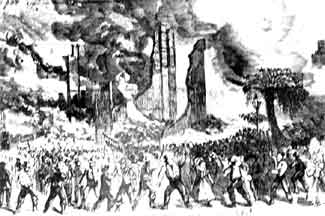1863 Draft Riots in New York

The Civil War was the first American war in which soldiers were drafted. The South was the first to employ the draft, followed by the North. In March of 1863, the National Conscription Act was passed. Draftees would be called by lottery. Once they were called, draftees had the opportunity to either pay a commutation fee of $300 for this draft, or hire replacements that exempted them for the entire war. In July 1863, draft riots broke out in New York. Over the course of the riots, Blacks were often the target of many rioters. Lincoln sent federal troops to put down the riots. There are various estimates of the number of dead and wounded ranging from 70 to 1,000..
African Americans were specifically targeted during the riots. Many were beaten, lynched, or killed by the mobs. Their homes and businesses were burned and destroyed. This kind of direct, racially-motivated violence sowed fear and uncertainty within the Black community.
Due to the immediate threat to their safety and property, many African Americans fled New York City, either temporarily or permanently. The Black population in the city decreased significantly after the riots, with many moving to places they perceived as safer, such as Brooklyn or New Jersey.
The Black community faced significant economic hardships as a result of the riots. Numerous properties owned by African Americans were damaged or destroyed, including homes, businesses, and institutions. This destruction represented both immediate economic loss and a longer-term impediment to economic recovery
The riots exacerbated racial tensions in the city. The targeting of African Americans during the riots deepened the divide between the Black community and some white communities, especially among those who had participated in or sympathized with the rioters.
In the aftermath of the riots, some African Americans felt a renewed urgency to organize and advocate for their rights. They realized that political engagement and community cohesion were essential for their protection and progress. This led to increased involvement in abolitionist activities, support for the Union war effort, and participation in emerging civil rights movements.
African Americans found it increasingly difficult to secure jobs in certain sectors after the riots. They were often pushed out of occupations they had previously held, particularly in dockyards and certain industries, as racial tensions and resentments persisted.
 >
>